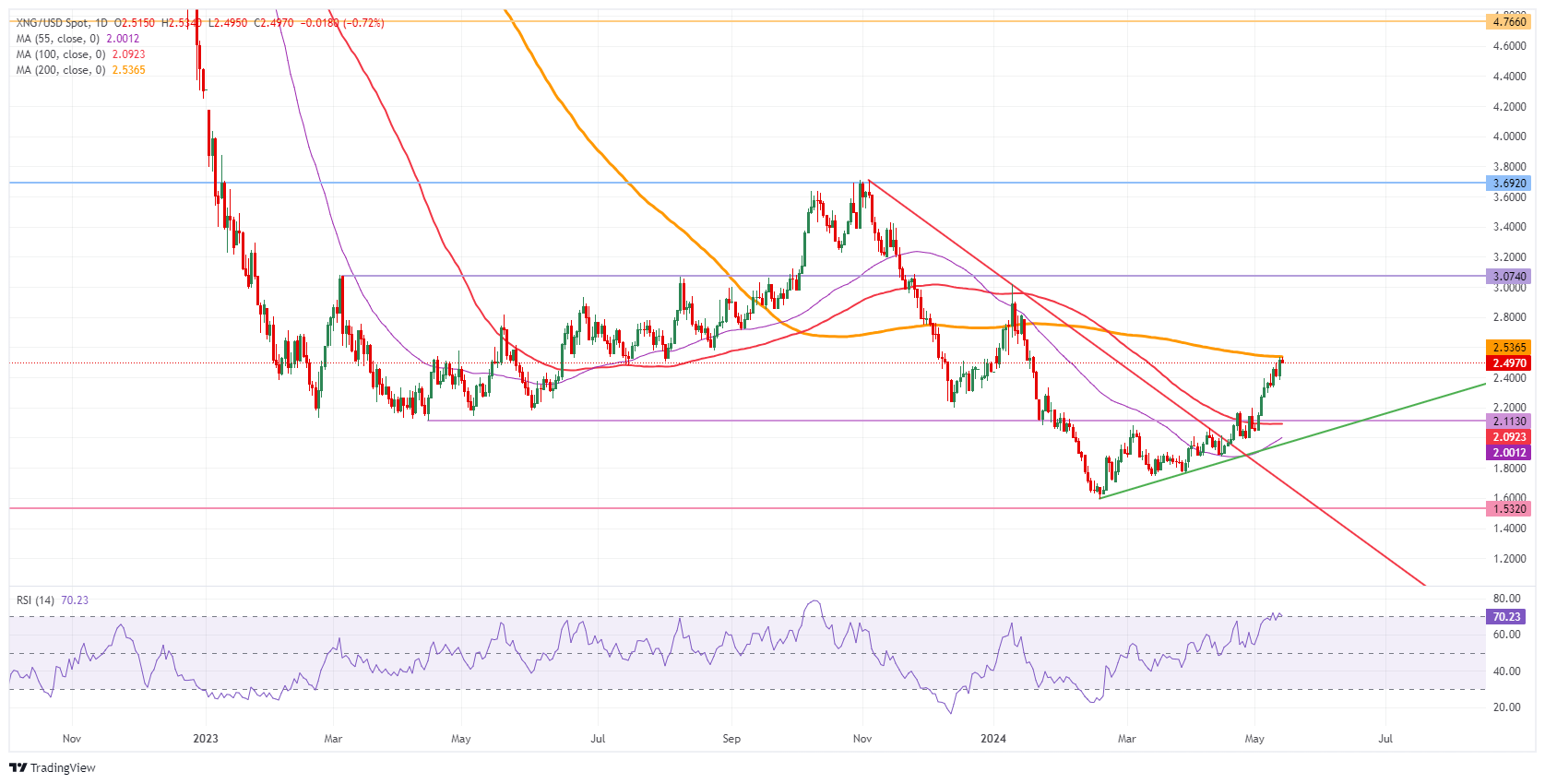Natural Gas undergoes rejection after hitting end-of-the-line for the March rally

- Natural Gas prices are facing a substantial cap at $2.53.
- Geopolitical risks ease a bit while the Qatar Economic Forum gets underway.
- The US Dollar Index holds and consolidates above 105.00.
Natural Gas price (XNG/USD) has given traders a nice run, rallying 40% since the end of March. This movement partially came on the back of Israel and its continuing attacks on Gaza. With pressure building from world leaders, calling out Israel to at least have a ceasefire, tensions are likely to ease from here. Meanwhile, Europe has secured enough Gas supply before the next heating season and ahead of the substantial longer-term measures that will kick in as of 2025 in 2028, making the bloc independent from Russian Gas.
The US Dollar Index (DXY), which tracks the Greenback’s value against six major currencies, trades steadily above the crucial support of 105.00 on Tuesday ahead of the speech from the US Federal Reserve (Fed) Chairman Jerome Powell. Markets are already bracing for the Consumer Price Index (CPI) for April, which is set to be released on Wednesday, so any words from Fed Chairman Powell on possibly keeping rates higher for longer might influence the initial Fed rate cut prospects to later 2024 or even earlier 2025. The outcome of that scenario would be a stronger US Dollar across the board, weighing on Gas prices denominated in USD.
Natural Gas is trading at $2.49 per MMBtu at the time of writing.
Natural Gas news and market movers: Comments to be released out of Qatar
- The Qatar World Economic Forum started on Tuesday morning. Headlines from world leaders may come out throughout the week. Prime Minister of Qatar, Mohammed bin Abdulrahman Al Thani, already kept an opening statement, condemning Israel’s approach towards Gaza and calling for peace and a ceasefire to work out a deal that works for all parties, Bloomberg Television broadcasted.
- The OPEC Monthly Market Report will be released on Tuesday. Although it deals with Oil, the energy complex as a whole might face some head or tailwinds from any outlook or firm changes in its policy.
- Germany will need to diversify its energy capacity by building new gas-fired plants as Bloomberg calculated that 25% of the current coal plants are set to close by the end of the year.
- The Freeport LNG plant is producing Liquified Natural Gas at the highest level in six months after a prolonged period of unforeseen outages and maintenance. Currently, the three production trains are jointly producing 2.09 billion cubic feet of Gas per day, Reuters reports.
Natural Gas Technical Analysis: Rally fatigue
Natural Gas rally trade since the end of April is running out of steam. The rally has reached the end of the line and faces a firm rejection against the 200-day Simple Moving Average (SMA) at $2.53 on Tuesday. A big catalyst or driver will be needed to push through that cap on the topside.
If Gas price breaks above the 200-day SMA, the $3.00 marker is the first level to watch. Once through there, the pivotal level near $3.07 (high of March 6, 2023) will come into play and mark a new high for 2024. Further up, there is room for a quick crossing towards $3.69.
On the downside, a double belt is awaiting to provide support with the 100-day SMA at $2.09 and the pivotal level at $2.11 (low of April 14, 2023). Should this support area fail to hold, then the ascending green trendline near $1.98, together with the 55-day SMA at $2.00, should avoid a further decline.
Natural Gas: Daily Chart
Natural Gas FAQs
Supply and demand dynamics are a key factor influencing Natural Gas prices, and are themselves influenced by global economic growth, industrial activity, population growth, production levels, and inventories. The weather impacts Natural Gas prices because more Gas is used during cold winters and hot summers for heating and cooling. Competition from other energy sources impacts prices as consumers may switch to cheaper sources. Geopolitical events are factors as exemplified by the war in Ukraine. Government policies relating to extraction, transportation, and environmental issues also impact prices.
The main economic release influencing Natural Gas prices is the weekly inventory bulletin from the Energy Information Administration (EIA), a US government agency that produces US gas market data. The EIA Gas bulletin usually comes out on Thursday at 14:30 GMT, a day after the EIA publishes its weekly Oil bulletin. Economic data from large consumers of Natural Gas can impact supply and demand, the largest of which include China, Germany and Japan. Natural Gas is primarily priced and traded in US Dollars, thus economic releases impacting the US Dollar are also factors.
The US Dollar is the world’s reserve currency and most commodities, including Natural Gas are priced and traded on international markets in US Dollars. As such, the value of the US Dollar is a factor in the price of Natural Gas, because if the Dollar strengthens it means less Dollars are required to buy the same volume of Gas (the price falls), and vice versa if USD strengthens.
